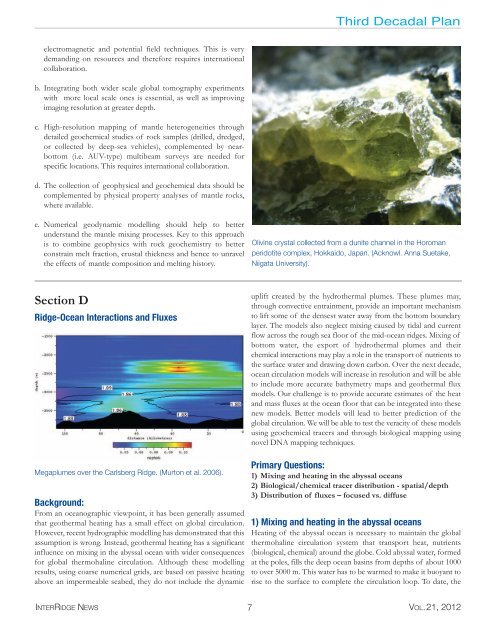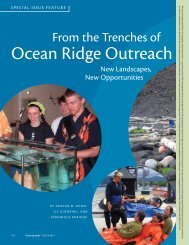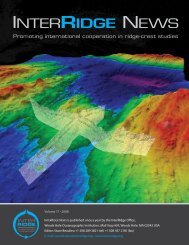Full version, low resolution, 7.5MB - InterRidge
Full version, low resolution, 7.5MB - InterRidge
Full version, low resolution, 7.5MB - InterRidge
Create successful ePaper yourself
Turn your PDF publications into a flip-book with our unique Google optimized e-Paper software.
Third Decadal Plan<br />
electromagnetic and potential field techniques. This is very<br />
demanding on resources and therefore requires international<br />
collaboration.<br />
b. Integrating both wider scale global tomography experiments<br />
with more local scale ones is essential, as well as improving<br />
imaging <strong>resolution</strong> at greater depth.<br />
c. High-<strong>resolution</strong> mapping of mantle heterogeneities through<br />
detailed geochemical studies of rock samples (drilled, dredged,<br />
or collected by deep-sea vehicles), complemented by nearbottom<br />
(i.e. AUV-type) multibeam surveys are needed for<br />
specific locations. This requires international collaboration.<br />
d. The collection of geophysical and geochemical data should be<br />
complemented by physical property analyses of mantle rocks,<br />
where available.<br />
e. Numerical geodynamic modelling should help to better<br />
understand the mantle mixing processes. Key to this approach<br />
is to combine geophysics with rock geochemistry to better<br />
constrain melt fraction, crustal thickness and hence to unravel<br />
the effects of mantle composition and melting history.<br />
Olivine crystal collected from a dunite channel in the Horoman<br />
peridotite complex, Hokkaido, Japan. (Acknowl. Anna Suetake,<br />
Niigata University).<br />
Section D<br />
Ridge-Ocean Interactions and Fluxes<br />
Megaplumes over the Carlsberg Ridge. (Murton et al. 2006).<br />
Background:<br />
From an oceanographic viewpoint, it has been generally assumed<br />
that geothermal heating has a small effect on global circulation.<br />
However, recent hydrographic modelling has demonstrated that this<br />
assumption is wrong. Instead, geothermal heating has a significant<br />
influence on mixing in the abyssal ocean with wider consequences<br />
for global thermohaline circulation. Although these modelling<br />
results, using coarse numerical grids, are based on passive heating<br />
above an impermeable seabed, they do not include the dynamic<br />
uplift created by the hydrothermal plumes. These plumes may,<br />
through convective entrainment, provide an important mechanism<br />
to lift some of the densest water away from the bottom boundary<br />
layer. The models also neglect mixing caused by tidal and current<br />
f<strong>low</strong> across the rough sea floor of the mid-ocean ridges. Mixing of<br />
bottom water, the export of hydrothermal plumes and their<br />
chemical interactions may play a role in the transport of nutrients to<br />
the surface water and drawing down carbon. Over the next decade,<br />
ocean circulation models will increase in <strong>resolution</strong> and will be able<br />
to include more accurate bathymetry maps and geothermal flux<br />
models. Our challenge is to provide accurate estimates of the heat<br />
and mass fluxes at the ocean floor that can be integrated into these<br />
new models. Better models will lead to better prediction of the<br />
global circulation. We will be able to test the veracity of these models<br />
using geochemical tracers and through biological mapping using<br />
novel DNA mapping techniques.<br />
Primary Questions:<br />
1) Mixing and heating in the abyssal oceans<br />
2) Biological/chemical tracer distribution - spatial/depth<br />
3) Distribution of fluxes – focused vs. diffuse<br />
1) Mixing and heating in the abyssal oceans<br />
Heating of the abyssal ocean is necessary to maintain the global<br />
thermohaline circulation system that transport heat, nutrients<br />
(biological, chemical) around the globe. Cold abyssal water, formed<br />
at the poles, fills the deep ocean basins from depths of about 1000<br />
to over 5000 m. This water has to be warmed to make it buoyant to<br />
rise to the surface to complete the circulation loop. To date, the<br />
INTERRIDGE NEWS 7 VOL.21, 2012
















